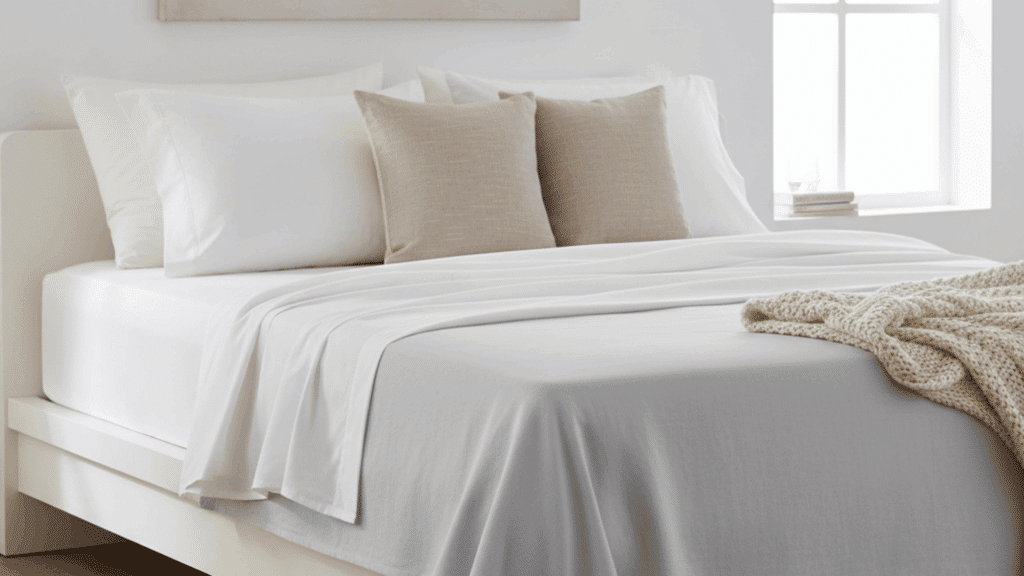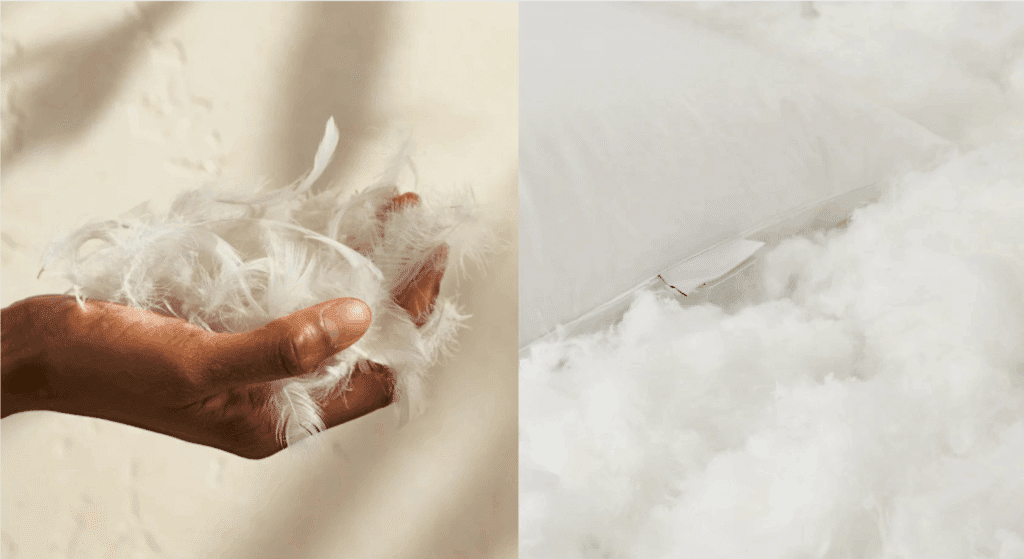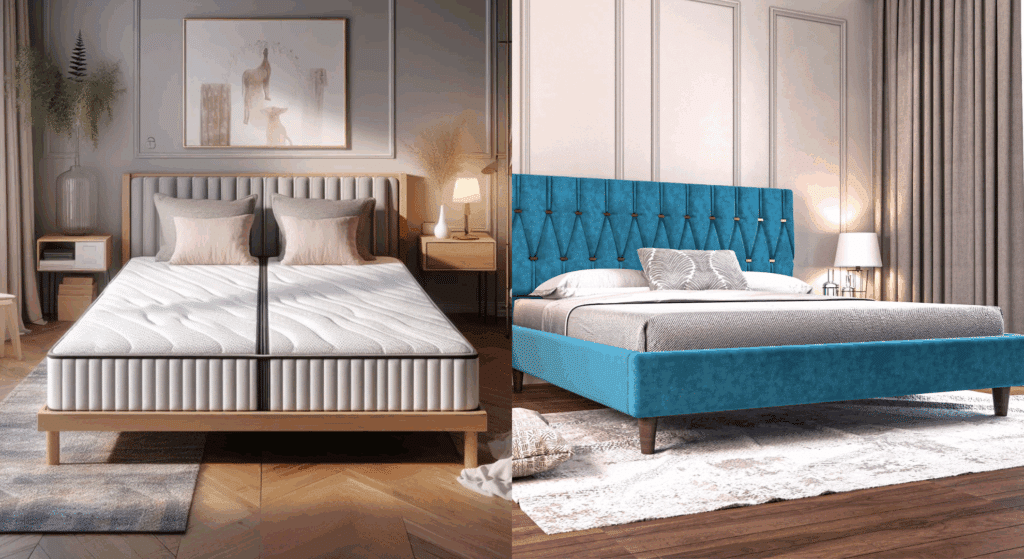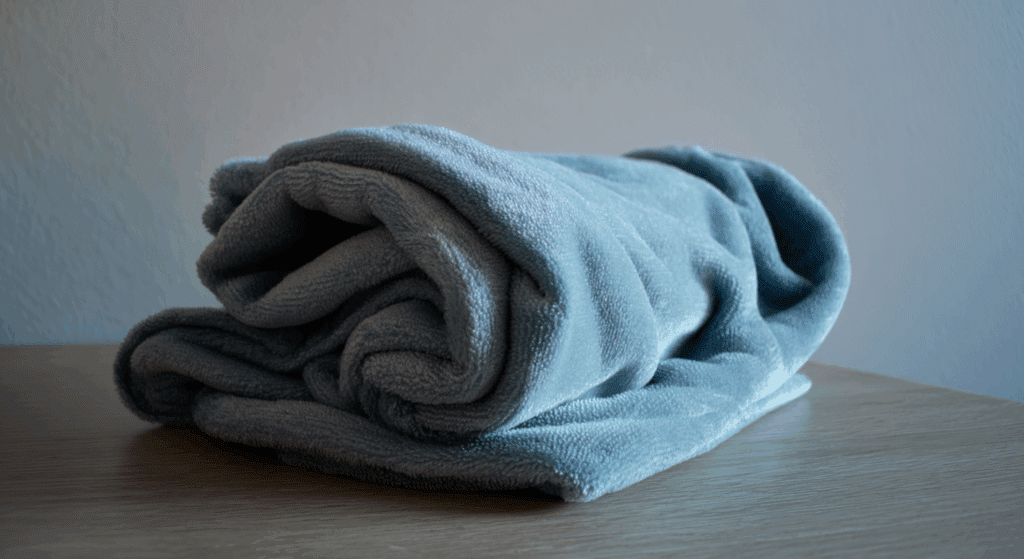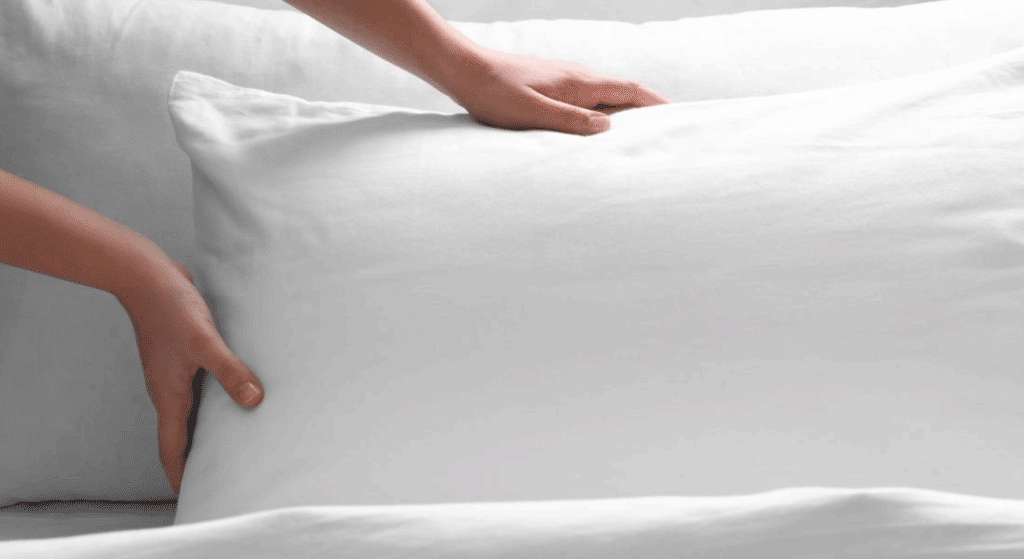If you’ve ever struggled to make your bed and couldn’t figure out why one sheet keeps slipping off, you’re not alone. I’ve been there, too.
That tricky sheet is called a fitted sheet, and it’s one of the most useful parts of your bedding set. But what exactly is a fitted sheet, and how is it different from a flat sheet?
In this blog, I’ll walk you through what makes a fitted sheet special, how it works, and when to use one.
I’ll also look at the key differences between flat sheets vs. fitted sheets so you can choose the right setup for your bed, and finally stop wrestling with your sheets every morning.
Why Bed Sheets Matter More Than You Think
Most of us don’t give much thought to our bed sheets; we just grab whatever matches the bedding set. However, the type of sheet you use can significantly impact how well you sleep.
The right sheet helps control temperature, keeps your mattress clean, and makes your bed feel softer and fresher every night.
Think of your bed as more than just a place to sleep; it’s where comfort begins. A good sheet setup can transform an ordinary mattress into a cozy retreat.
Before learning about fitted sheets and flat sheets, it’s worth understanding how each one adds its own layer of comfort, protection, and style to your bed.
What is a Fitted Sheet?
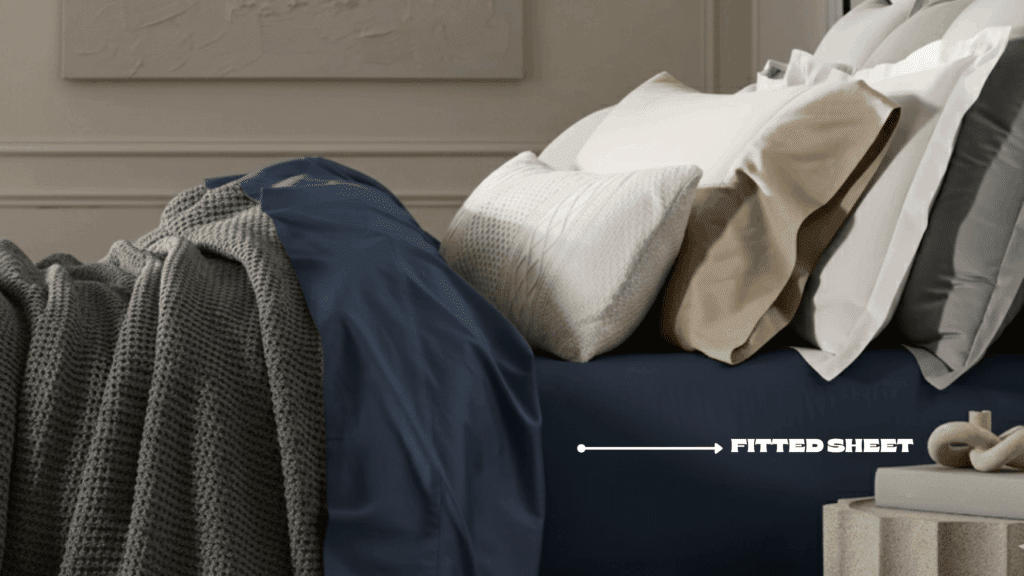
A fitted sheet is a type of bed sheet made to fit snugly over your mattress. It has elastic corners or edges that stretch and wrap around the mattress to keep it from slipping off during the night.
This design helps the sheet stay smooth and tight, even if you move around in your sleep.
Fitted sheets act as the bottom layer of your bedding. They protect the mattress from dust, sweat, and everyday wear, while providing a clean and soft sleeping surface.
Most fitted sheets are made from materials like cotton, bamboo, or microfiber and come in all mattress sizes: Twin, Full, Queen, King, and more, so you can always find one that fits perfectly.
Benefits of Fitted Sheets
Fitted sheets aren’t just for looks; they make your bed more comfortable, protect your mattress, and save you time when it comes to cleaning and styling.
- Stay in Place All Night: The elastic corners keep the sheet from slipping or bunching, even if you move around.
- Smooth Sleeping Surface: Creates a flat, wrinkle-free layer for better comfort.
- Protects Your Mattress: Keeps dust, sweat, and dirt away, helping your mattress stay fresh longer.
- Easy to Wash and Change: Simple to remove and toss in the laundry.
- Neat and Polished Look: Gives your bed that tidy, hotel-style finish.
Overall, a fitted sheet is a small but essential bedding item that makes a significant difference in how your bed feels and looks every day.
What is a Flat Sheet?
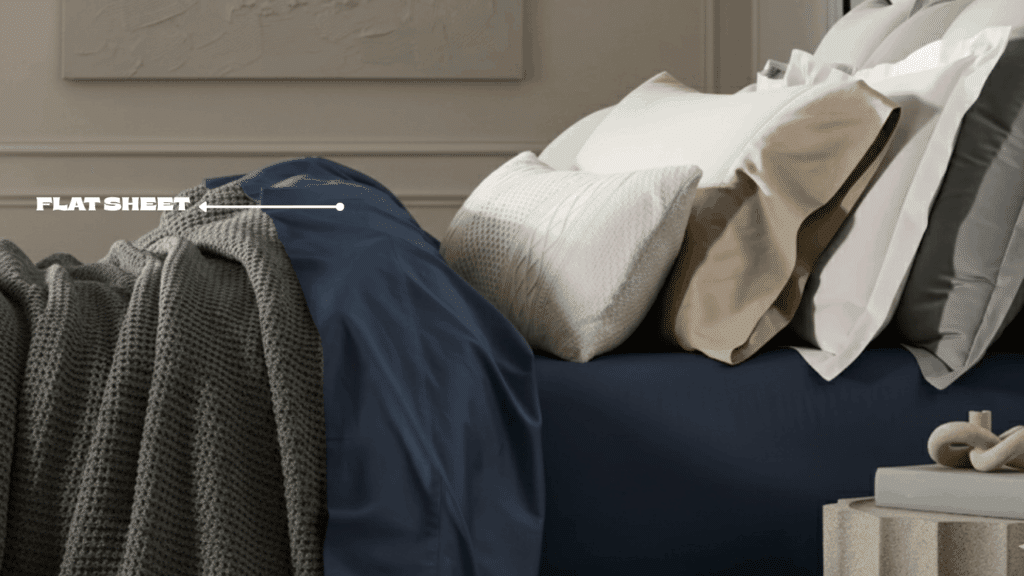
A flat sheet, sometimes referred to as a top sheet, is a simple, rectangular piece of fabric that lies between you and your blanket or comforter.
It’s designed to add a soft, breathable layer for comfort while keeping your duvet or comforter cleaner for longer.
Flat sheets can also help regulate temperature, keeping you cool in summer and warm in winter. They come in fabrics like cotton, linen, and bamboo, and fit mattress sizes such as Twin, Queen, and King.
Some people love using both a flat and fitted sheet together for a complete, cozy setup, while others prefer just one for a simpler routine.
Benefits of Flat Sheets
Flat sheets do more than add an extra layer; they help keep your bedding fresh, make your bed feel softer, and add a touch of style.
- Keeps Bedding Clean: Acts as a barrier between your body and the duvet or blanket, reducing the frequency of washing.
- Adds Comfort: Provides a soft, breathable layer that feels gentle on the skin.
- Regulates Temperature: Helps you stay cool in warm weather and cozy in cooler months.
- Improves Bed Appearance: Creates a full, layered look often seen in hotel beds.
- Flexible Use: Suitable for use alone in summer or layered with blankets in winter.
In short, a flat sheet keeps your bed cleaner, cozier, and more stylish, making it a simple upgrade for a better night’s sleep.
Flat Sheet vs. Fitted Sheet: Quick Comparison
Flat and fitted sheets might look similar at first, but they serve very different purposes. Here’s a quick comparison to help you understand the differences between them.
| Feature | Flat Sheet | Fitted Sheet |
|---|---|---|
| Shape | Large, flat rectangle with no elastic | Has elastic corners that fit snugly around the mattress |
| Use | Placed on top of the fitted sheet, under the blanket | Used as the bottom sheet directly on the mattress |
| Fit | Needs to be tucked in to stay in place | Holds tightly without tucking |
| Look | Adds a layered, hotel-style finish | Creates a clean, smooth surface |
| Folding | Easy to fold and store | Harder to fold neatly due to elastic edges |
Both sheets serve unique purposes; the fitted sheet keeps your mattress clean and tight, while the flat sheet adds comfort and style on top. Using both together creates the perfect mix of practicality and luxury.
Design Features of Fitted Sheets
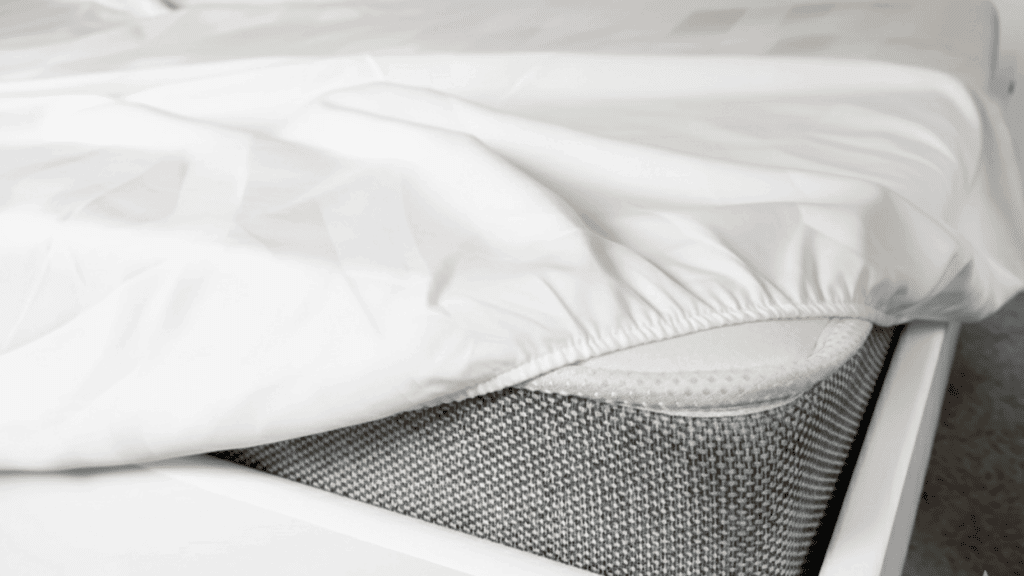
Fitted sheets are thoughtfully made to combine comfort, convenience, and style. Each feature serves a purpose, from maintaining stability to improving durability and softness.
1. Elastic Edges
The most important feature of a fitted sheet is its elastic edges. These stretchy bands run around the corners or the entire edge, gripping the mattress tightly.
They keep the sheet from slipping off during sleep, so your bed stays neat and smooth every night without constant adjusting.
2. Pocket Depth
Fitted sheets come in different pocket depths to match various mattress thicknesses. Standard sheets fit thinner mattresses, while deep or extra-deep pockets are made for thicker beds and mattress toppers.
Choosing the right pocket depth ensures that your fitted sheet hugs the mattress perfectly, without sliding or bunching up.
3. Box-Like Fit
A fitted sheet has a box-like shape that wraps securely around your mattress, covering it from top to bottom, providing a snug fit.
This snug design creates a flat, wrinkle-free surface that feels smooth and looks tidy. It also helps prevent bunching, giving your bed that crisp, hotel-style appearance every day.
4. Material Choices
Fitted sheets are available in a variety of materials, each offering different benefits. Cotton and bamboo provide breathability and softness, while microfiber offers an affordable, easy-care option.
Some luxury fabrics, such as linen or sateen, feel silky and smooth. The right material depends on your comfort preferences and sleep style.
5. Corner Seams
Strong corner seams are crucial for durability and maintaining a long-lasting shape. These reinforced stitches keep the elastic edges secure, preventing tearing or stretching over time.
Even after multiple washes, well-made seams help the sheet retain its fit, so it stays tight and smooth on your mattress for years.
Can You Use a Flat Sheet as a Fitted Sheet?
You can use a flat sheet instead of a fitted sheet, but it’s not the most practical option. To make it work, spread the flat sheet evenly over the mattress and tuck the edges tightly under each corner.
This can help keep it in place for a while, but since flat sheets don’t have elastic, they often loosen or slip off during the night, especially if you move around a lot.
It also takes more effort to tuck and retuck each morning. So, while a flat sheet can be a quick backup, a fitted sheet is always the better choice for a smooth, secure, and comfortable fit.
How to Choose the Right Fitted Sheet
Choosing the right fitted sheet is crucial for comfort, a proper fit, and easy care. A few key details can help you find the perfect one for your mattress and sleeping style.
- Size: Always match your fitted sheet to your mattress size, whether it’s Twin, Full, Queen, King, or California King, for a perfect fit.
- Pocket Depth: Standard sheets fit mattresses up to 14 inches deep, while deep-pocket sheets suit mattresses 15–18 inches deep, and extra-deep ones fit mattresses over 18 inches deep.
- Material: Cotton offers softness and breathability, bamboo keeps you cool, and microfiber provides an affordable, low-maintenance option.
- Weave: Choose percale for a crisp feel, sateen for silky smoothness, or jersey for a soft, stretchy texture.
By picking the right size, depth, and material, your fitted sheet will stay snug, feel comfortable, and make your bed look perfectly put together.
Fitted and Flat Sheet Size Chart
Selecting the correct sheet size makes a significant difference in how your bed looks and feels. Use this guide to find the correct dimensions for both fitted and flat sheets based on your mattress size.
| Mattress Size | Mattress Dimensions (inches) | Fitted Sheet Dimensions (inches) | Flat Sheet Dimensions (inches) |
|---|---|---|---|
| Twin | 39″ x 75″ | 39″ x 75″ + up to 14″ deep | 66″ x 96″ |
| Twin XL | 39″ x 80″ | 39″ x 80″ + up to 14″ deep | 66″ x 100″ |
| Full (Double) | 54″ x 75″ | 54″ x 75″ + up to 16″ deep | 81″ x 96″ |
| Queen | 60″ x 80″ | 60″ x 80″ + up to 18″ deep | 90″ x 102″ |
| King | 76″ x 80″ | 76″ x 80″ + up to 18″ deep | 108″ x 102″ |
| California King | 72″ x 84″ | 72″ x 84″ + up to 18″ deep | 102″ x 110″ |
Flat sheets are more forgiving in size, so a slightly larger one can still be tucked in neatly.
Conclusion
After learning about both fitted and flat sheets, I’ve realized that choosing the right one can significantly impact the comfort of your bed.
A fitted sheet keeps everything snug and smooth, while a flat sheet adds that extra touch of softness and protection. Both play important roles, and together they create the perfect balance between comfort and care.
I like to think of them as a team; one keeps things in place, and the other adds the finishing touch.
Regardless of your preference, investing in high-quality sheets is one of the simplest ways to make your sleep space feel fresh, cozy, and inviting every night.

